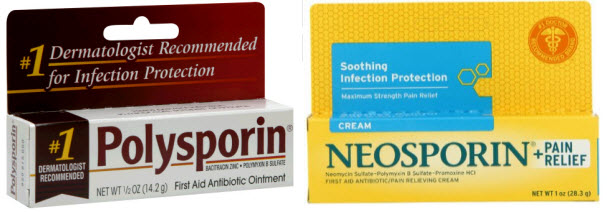In modern medicine, antibiotics are often the first line of defense (disregarding the human immune system) against infection and diseases. There are numerous antibiotics currently in use by health care professional. Neosporin and Polysporin are commonly used topical antibiotics, usually in the form of a cream, which are generally administered for treatment of minor lacerations, cuts and scrapes. The use of these antibiotics will help to speed up the process of healing. However, it is important to remember that there are both similarities and differences between the Polysporin vs Neosporin.

Polysporin vs Neosporin: Which One Is Better for You?
Both of these antibiotics can be purchased over-the-counter in the form of a cream, and when applied, both can help with the healing process and prevent infections. It is always handy to keep at least one of these creams on hand at home in case you or a loved one get cut, scraped, or injured. So which of these two antibiotic creams is the better for you?
1. Difference in Ingredients
The antibacterial properties of Polysporin are attributed to the ingredients: gramicidin, bacitracin zinc and polymyxin B. Together, these three antibiotic ingredients eradicate bacteria. Much like Polysporin, Neosporin’s antibiotic properties is attributed to neomycin sulfate, bacitracin zinc and polymyxin B.
2. Possible Side Effects
When comparing Polysporin vs Neosporin, it is important to understand what side effects these active ingredients can have.The ingredient bacitracin within Polysporin may cause an instance of allergic contact dermatitis when applied to the skin. That being said, the ingredient within Neosporin, neomycin, can be considered worse. Neomycin is believed to be one of the most common instigators of dermatitis. For that reason, for someone showing an allergic reaction after using Neosporin, Polysporin may be prescribed (although as mentioned, this can still cause a reaction).
3. Active Pain-Relief
Along with antibacterial properties, Polysporin also has added pain relieving properties. The active ingredient added is lidocaine hydrochloride, which works effectively to reduce pain sensations. Much like Polysporin, Neosporin also has an added active pain-relieving agent, named pramoxine. This added ingredient works to relieve the pain associated with the injury being treated.
4. Preference of Use
When considering Polysporin vs Neosporin, the use of Polysporin is usually more advised due to the fact that there is a less likely chance of an allergic reaction. The use of Neosporin may be suggested when other commonly used antibiotic medications have no effect.
Precautions of Using Polysporin or Neosporin
As with any type of drug or medication, there are a few precautions to note before using Polysporin vs Neosporin. If you are unsure as to whether or not any medication is appropriate for use, then speak with your doctor. This is especially true in these instances:
- If you have any known allergies to antibacterial agents such as neomycin, gramicidin, polymyxin, et cetera, or any other known allergies. Both Polysporin and Neosporin contain active ingredients that may trigger allergic reactions.
- If you have a medical history, especially some skin problems, such as viral skin infections, eczema, cold sores, chickenpox, shingles, and so on, then speak with your doctor before using any of these medications.
- If you are currently using any other pharmaceutical or herbal drugs and remedies, then consult your pharmacist or doctor before using these medications to see if there are any unwanted interactions.
- If you are due to have any surgical procedures, then tell your health care provider (be they surgeon or dentist) that you are using Polysporin or Neosporin.
- If you are pregnant, then it is important to speak with a medical professional before using any medication. Even though when comparing Polysporin vs Neosporin, Polysporin poses less chance of an adverse reaction, that does not mean it should be used without medical advice.
